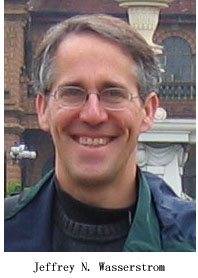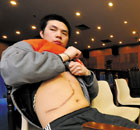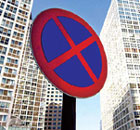Think Tank
A Tale of Two American Presidents' Trips to China
By Maura Elizabeth Cunningham and Jeffrey N. Wasserstrom (Chinadaily.com.cn)
Updated: 2010-02-21 09:35
 |
Large Medium Small |
There was a lot of debate in the American press late last year over whether Barack Obama’s first trip to China was a success, but there was a consensus on one thing: it was best understood in light of the visits to Beijing that other American presidents have made since the seventies.
We agree. But we do not just mean the 1970s, which is as far back as other commentators tended to go. We think that a look back to the 1870s has at least as much to tell us.

When it comes to approaches to some political issues, recent history may be the only place one needs to turn. For a sense of what U.S.-Chinese interactions can reveal about the way global hierarchies change over time, however, it is crucial to move between the present moment (near the end of the first decade of what some insist will be "The Chinese Century") and the late 1800s (when the period often dubbed "The American Century" was about to begin).
The relevance of the 1970s is obvious. When Nixon went to China near the start of that decade, he was the first sitting American President to do so, and the decade ended with the full "normalization" of ties between Washington and Beijing.
The significance of the 1870s lies in the fact that Ulysses S. Grant was on a world tour that included a stop in China as that decade came to a close. And although by the time Grant did his globetrotting, he was a former occupant of the White House, he did many of the same things in China that ex-President that Nixon, Obama, and all recent Commanders-in-Chief in between have done while in office.
Grant met with some of China's leaders (including Li Hongzhang) to discuss U.S.-China relations. He expressed the hope for a future in which closer ties would develop between our “young” country and the “ancient” one across the Pacific. And he even went to see the Great Wall and reflected on its meaning. In his case, inspired by a comment about the landmark made by William H. Seward (a member of Abraham Lincoln's storied "team of rivals" who made it to China earlier in the 1870s), Grant mused on the fact that as much labor was probably required to construct it as had been expended on building all of America's railroads, which at the time were considered marvels of state-of-the-art engineering.
Continuities of this sort are interesting--to us and perhaps also to our President, given his oft-noted fascination with nineteenth-century history. But the biggest pay-off to looking back to the 1870s lies in alerting us to a series of reversals, in each of which one can see parallels between today’s China and Grant’s America.
One such striking parallel relates to large-scale global events. The most important of these in Grant’s day were World’s Fairs, and just three years before his trip to China, he had presided over the first of these ever held outside of Europe. That spectacle, the 1876 Philadelphia Centennial Exhibition, signaled America’s entry into the charmed circle of thoroughly modern lands. It was a wake-up call to established powers such as France and Great Britain that the ground was shifting under their feet--though the impressive showing American industry had made the Crystal Palace Exhibition of 1851, the very first World's Fair, had made some European leaders take notice even earlier.
The Olympics are now as important as World’s Fairs once were. And when Obama went to China, it was his Chinese counterpart, Hu Jintao, who was fresh from presiding over a grand spectacle, the 2008 Beijing Games, which was the first event of its kind held on Chinese soil. Like the Philadelphia World's Fair, it was viewed by many as an impressively produced gala. And like that International Exhibition, it was interpreted as symbolizing that a familiar geopolitical landscape had been altered, and would soon perhaps be transformed further.
Another reversal of positions between Grant’s day and Obama’s relates to education. In 1879, as in 2009, student exchanges were hailed as a promising method for increasing mutual understanding between the United States and China. But Grant emphasized the value of more Chinese students coming here to learn our modern ways, while Obama stressed the need for more American youths to study in China.
These kinds of switches should not surprise us for, the great contrasts relating to political systems aside, China is now much like the U.S. was then. This is a point that others have made before us, including American historian Stephen Mihm, whose essay "A Nation of Outlaws"(Boston Globe, August 26, 2007) traces parallels between the way an era of "exuberant capitalism" played out on our side of the Pacific over a century ago and is now unfolding in China.
It is now China, not the United States, that is a rapidly industrializing nation whose rise is generating wonder and concern. It is now China, not the United States, whose new trains and railway lines impress those in other countries—a point that President Obama alluded to last month in his first State of the Union Address. And it is now China whose growing economic clout, combined with a sense that its rise may have only begun, is sending the same kinds of shockwaves through the geopolitical landscape that the surge of the United States generated back when the global order was dominated solely by Western European powers.
Keeping the 1970s in mind when thinking about Obama’s trip is useful, as it helps us appreciate some important issues. For example, the degree to which economic and environmental challenges have replaced Cold War ones in pushing China and the United States together, while also making it difficult for the two countries to form an effective partnership, an international counterpart to the "team of rivals" so admired by Obama.
It is at least as important, though, to go back to the 1870s. To a time, long before ping-pong diplomacy, when the United States was the energetic, continent-sized Pacific power whose upward trajectory was a source of fascination and concern.
About the authors:
Maura Elizabeth Cunningham is the Editor of the “China Beat” blog/electronic magazine and a graduate student in history at the University of California, Ivrine.
Jeffrey N. Wasserstrom is a Professor of History at the University of California, Irvine, and the author, most recently, of “China in the 21st Century: What Everyone Needs to Know” (Oxford University Press, April 2010).
Note: an earlier version of this essay appeared on the “History News Network” website.









